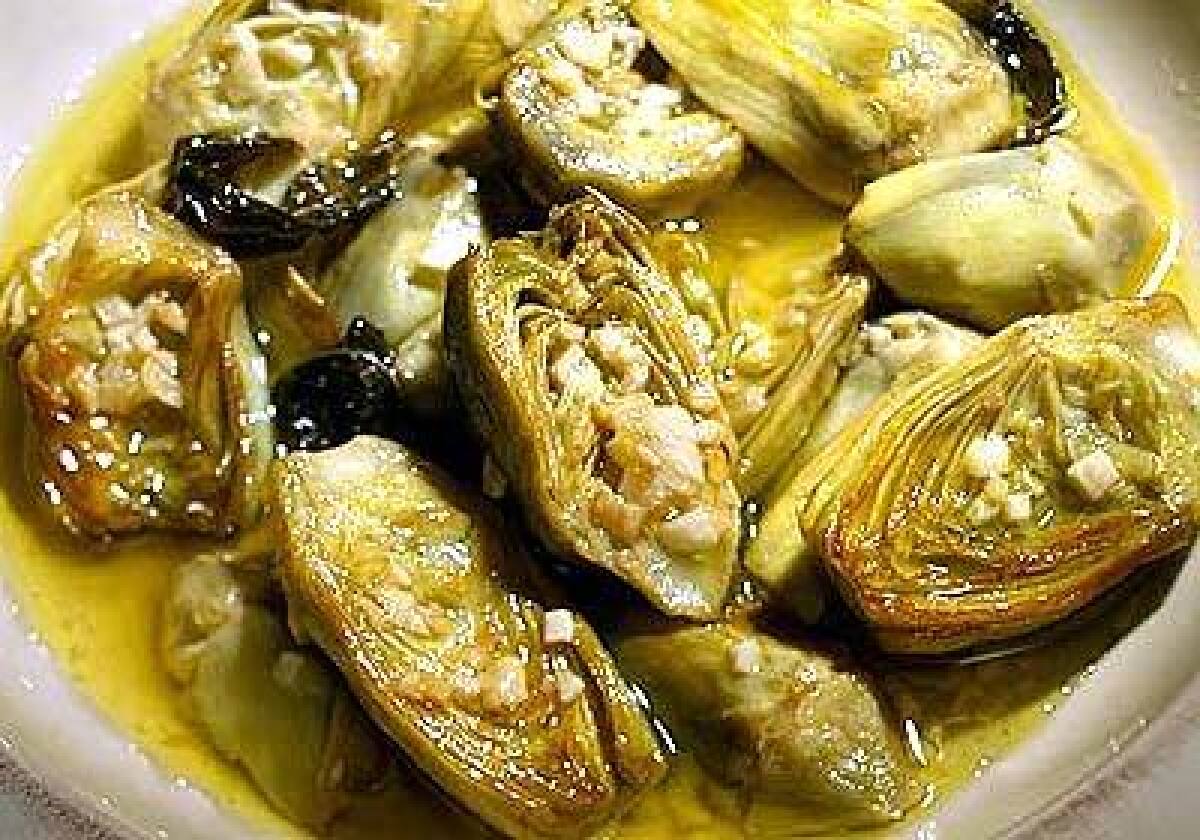A virtual Roman holiday

Tuscany’s out; Lazio’s in.
Lazio, in case your geography’s rusty, is the region halfway down Italy’s western coast, in the middle of which sits Rome. Rome isn’t known as one of the world’s — or even Italy’s — great food cities, perhaps because the cooking’s fairly simple, and there’s a shortage of the kind of restaurants the Michelin guide would want to shower with stars. But visit Rome and you will eat very, very well. Visit Rome’s markets, and you will wish you lived there, so you could cook.
Rome’s summer markets are filled with artichokes, gorgeous tomatoes in a dozen shapes and sizes, fava beans, fennel — all the same stuff that grows so well in Southern California. (Of course you find baby octopus and fresh anchovies and fat porcini there too, but who’s counting?) So Roman cooking has terrific appeal for Angelenos.
Just in time for summer produce, two new cookbooks celebrate Rome and its cooking.
FOR THE RECORD: Cookbooks -- A review of cookbooks in the Food section June 2 gave the wrong name for one of the books. It is titled “Rome, at Home: The Spirit of La Cucina Romana in Your Own Kitchen,” not “Rome, at Home: The Spirit of La Cucina Roma in Your Own Kitchen.” Also, the review stated that the author, Suzanne Dunaway, is based in L.A. and is the force behind the bakery Buona Forchetta Hand Made Breads. In fact, Dunaway resides in Rome and is no longer associated with the bakery.
You may know Suzanne Dunaway’s baked goods — based in L.A., she’s the force behind Buona Forchetta Hand Made Breads. Her love for Italian-style bread was no doubt kindled by her love affair with Rome, where she has spent much of her life, beginning with a post-college trip to the Eternal City, as she tells us in the introduction of “Rome, at Home: The Spirit of La Cucina Roma in Your Own Kitchen” (Broadway Books, $29.95). She married a man who lived and worked in Rome, and so spent the better part of 10 years there. Was he Roman? Did she actually live there with him? Is she still married to him? How much time has she spent there since? She’s a little sketchy on details.
No matter; she tells us plenty about the food. “Parli come mangi,” she explains, is romanesco (Roman dialect) for “Speak as you eat,” that is to say, plainly. “This directness is at the heart and soul of the Roman experience and especially la cucina romana.”
And the book itself is direct — no fancy photos, no clever division of recipes into flavor profiles — just 150 straightforward, appealing recipes, sensibly divided into antipasti; primi; secondi; contorni; pane, focaccia e pizza; and dolci. I want to make them all, from allici fritti (fried anchovies) to crostini di fegato (chicken liver pâté on toast) to pappardelle alla lepre (wide noodles with hare or rabbit).
Those I’ve tried have been simple to prepare and delicious. Straccetti con la rughetta (“tattered” strips of beef with arugula) showed up on Roman menus a few years ago, the headnote tells us, and is now very fashionable, “seen everywhere except in cookbooks.” Lean sirloin is cut into thin strips and browned quickly in a skillet, and a mess of arugula is tossed in at the last minute, just to wilt it. The flavor of Orecchiette con rapini (little ear-shaped pasta with broccoli rape) is deepened by anchovies and enlivened by a squeeze of lemon as it’s served, and you can put it together in no time flat. And Dunaway’s version of Carciofi alla romana, the traditional Roman preparation of artichokes with garlic and mint, is my absolute favorite this season, which for me has been a nonstop artichoke fest.
Julia della Croce’s “Roma: Authentic Recipes From In and Around the Eternal City” (Chronicle Books, $19.95), is a paperbound book with terrific photos by Paolo Destefanis. Della Croce, who is the award-winning author of 10 previous cookbooks, including “The Classic Italian Cookbook” (1996), reminds us that Italians say Rome has no cuisine of its own, but she asserts that that’s not true. She points to Romans’ bold use of pepper and other spices, their fondness for lard and other pork fat, along with olive oil, fennel, mint, cilantro and bitter chocolate (especially in stews and sweet-and-sour dishes).
In any case, it’s a little hard to focus on the quite-thorough explanations of ingredients such as pecorino and puntarella when a flip through the pages makes you want to pick up a pan.
Della Croce’s book is not as exhaustive as Dunaway’s, but there’s no shortage of wonderful dishes. Those I’ve tried have turned out so well, they’ve instantly joined my repertoire. “Jump-in-the-mouth” sautéed veal cutlets (Saltimbocca alla romana) sound like a silly escapee from a 1970s menu, but these simple little rolls of veal layered with prosciutto and fresh sage are irresistible. The instructions are a little goofy, though, insisting that you cut the meats into 2- by 4-inch rectangles, discarding any scraps. I did so, but I don’t discard veal or prosciutto, so I just made raggedly little rolls with the extras, and they were just as delicious. The recipe also forgets to say to roll them up before securing with toothpicks. Sometimes a picture is worth a thousand words.
For baby peas coddled in lettuce (Piselli alla lattuga), Della Croce calls for either fresh English peas or frozen baby peas. How good could it possibly be with frozen peas? Really good, it turns out. You line the pot with lettuce leaves, which impart a hint of flavor, and add finely chopped scallions and fresh mint leaves. I still don’t understand why it’s so good.
Another contorno (side dish), roasted onions with vinegar dressing (Cipolle al forno), is as simple as can be, with about five minutes of active preparation. But they’re so meltingly delicious — and beautiful — that I’ve not only made them thrice, but I’ve also given the recipe to my mother, who loved it so much that she gave it to a friend and my brother. With that kind of exponential recipe blabbing, it’s only a matter of time before they land on your table.
*
Saltimbocca alla romana (`Jump-in-the-mouth’ sautéed veal cutlets)
Total Time: 30 minutes
Servings: 4
Note: Adapted from “Roma,”
by Julia Della Croce
1 pound (12 small slices) tender milk-fed veal scaloppine cutlets
12 large fresh sage leaves
12 thin slices (not paper-thin) prosciutto
5 tablespoons unsalted butter, divided
2 tablespoons extra virgin olive oil, divided
Sea salt and freshly ground white or black pepper to taste
2 tablespoons water
1. Place a piece of waxed paper on a cutting board and place a slice of veal on it. Cover the meat with another piece of waxed paper. Using the blunt side of a meat mallet, pound lightly on both sides to flatten and tenderize, being sure not to break the meat. To pound the reverse side, just flip the meat over, sandwiched between the sheets of waxed paper. Flatten all the slices very thinly in this fashion, replacing the waxed paper when necessary. Cut each slice into a piece about 2 by 4 inches and discard the trimmed bits. You should have 12 thin scaloppine.
2. Place a sage leaf on each slice, then add a slice of prosciutto the same size as the veal. Roll up and secure with a toothpick.
3. In a large skillet, melt 2 tablespoons of the butter with 1 tablespoon olive oil over medium heat. Add half the veal, increase the heat to high, and sauté until lightly golden on the bottom, 2 or 3 minutes. Season the meat with salt and pepper as it sautés. Turn the rolled slices quickly to brown the other side for 2 minutes. Transfer the veal to a warmed dish. Add 2 more tablespoons of the butter and the remaining olive oil to the skillet and repeat to cook the remaining veal.
4. When all the meat has cooked, add the remaining tablespoon of butter and the water to the pan and stir. As soon as the butter melts, take it off the heat and pour it over the veal. Serve hot.
Each serving: 423 calories; 38 grams protein; 1 gram carbohydrates; 1 gram fiber; 30 grams fat; 13 grams saturated fat; 172 mg. cholesterol; 884 mg. sodium.
*
Roasted onions with vinegar dressing
Total time: 2 hours, largely unattended
Servings: 6
Note: From “Roma,” by Julia Della Croce
6 onions, peeled
Extra virgin olive oil for brushing
Sea salt to taste
White wine vinegar for sprinkling
Freshly ground black pepper to taste
1. Cut the onions in half crosswise. Place them in a bowl and add cold water to cover. Let stand for about 1 hour. Drain and pat dry.
2. Heat the oven to 350 degrees. Line a baking sheet with heavy-duty aluminum foil and coat with oil. Brush the onion halves all over with olive oil and place them, cut-side up, on the prepared pan. Sprinkle with salt and roast until thoroughly tender and nicely browned, about 1 hour.
3. Transfer to a serving dish. Sprinkle lightly with vinegar and generously with pepper to serve.
Each serving: 161 calories; 1 gram protein; 9 grams carbohydrates; 2 grams fiber; 14 grams fat; 2 grams saturated fat; 0 cholesterol; 3 mg. sodium.
*
Carciofi alla romana (artichokes with garlic and mint)
Total time: 45 minutes
Servings: 6
Note: From “Rome, at Home,” by Suzanne Dunaway
6 medium globe or 20 baby artichokes
1/2 cup extra virgin olive oil
6 garlic cloves, chopped
4 fresh mint sprigs, leaves only
1/2 teaspoon salt
1/2cup dry white wine or water
1 large lemon
1. Trim the leaves of the artichokes down to the yellow part, peel the stems and cut off the greenish tops to the yellow part.
2. Heat the olive oil in a large pot with a lid over medium heat, then add the artichokes, cutting each in half if you like to create more surface area to be browned. Cook for a few minutes, until golden, turning once, then add the garlic, mint leaves and salt.
3. Cover and simmer for 6 to 7 minutes, then add the wine or water, lower the heat, cover, and continue cooking for 15 to 20 minutes, until the artichokes are very tender. Squeeze the lemon juice over the artichokes and serve at room temperature in the oil.
Each serving: 240 calories; 4 grams protein; 15 grams carbohydrates; 6 grams fiber; 18 grams fat; 2 grams saturated fat; 0 cholesterol; 310 mg. sodium.
*
Straccetti con la rughetta (`Tattered’ strips of beef with arugula)
Total time: 20 minutes
Servings: 4
Note: From “Rome, at Home,” by Suzanne Dunaway
1 1/2 pounds lean sirloin, cut into 1/4-inch by 1/4-inch by 2-inch long strips
Salt and freshly ground pepper
1/4cup extra virgin olive oil or 4 tablespoons butter
1 large bunch arugula leaves, chopped if large, left whole if small
1. Sprinkle the meat with salt and pepper. Heat the oil or butter in a large skillet, add the meat, and brown quickly on all sides over high heat, about 5 minutes.
2. Add the arugula to the skillet, turn off the heat, toss with the straccetti and serve immediately.
Each serving: 397 calories; 37 grams protein; 1 gram carbohydrates; 0 fiber; 27 grams fat; 7 grams saturated fat; 98 mg. cholesterol; 93 mg. sodium
More to Read
Sign up for The Wild
We’ll help you find the best places to hike, bike and run, as well as the perfect silent spots for meditation and yoga.
You may occasionally receive promotional content from the Los Angeles Times.










